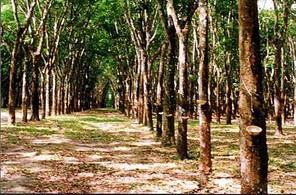- Home –
- Products –
- Informations –
- Contact –
- Amor

You can change the display size. Just use Crtl + mouse wheel or the keyboard shortcuts Ctrl-(+) or Ctrl-(-).
Amor Gummiwaren GmbH
August-Rost-Straße 4
99310 Arnstadt
Germany
+49(0)3628 66 287 -0
+49(0)3628 66 287 59

 Natural rubber [called in Indian kau-utschu >weeping
tree<] is the thick, milky suspension found in the sap of some
tropical plants.
Natural rubber [called in Indian kau-utschu >weeping
tree<] is the thick, milky suspension found in the sap of some
tropical plants.The most important rubber plant is the rubber tree (Hevea brasiliensis) which belongs to the spurge family and can grow to a height of 30 meters. It is indigenous to the rainforests of the Amazon and requires a warm, humid climate. Seed smuggling resulted in the tree being transplanted to other tropical regions, such as the Dutch Indies, in 1876 and an end to Brazil’s rubber monopoly. The guayule bush and the flowering plants of the taraxacum genus (similar to the dandelion) were important for producing rubber during the Second World War.
Wild rubber comes from trees that grow in the wild and is traded in the form of loaves (Para rubber). Primary producing region: Brazil.
Plantation or nursery rubber comes from systematically cultivated and managed plantations. It is clean and supplied in two main forms: as smoked sheets (yellow-brown, translucent slabs) and as crepes (thin, yellow, crinkled sheets). Primary producing regions: Southeast Asia and Africa. Collection begins with tapping. A special knife is used to cut V-shaped slits in the bark of the trees from which the latex flows into a container. This latex is a white liquid in which the rubber particles are distributed in the form of miniscule drops. It is similar to cow’s milk in many ways: it coagulates easily with the latex particles collecting like the cream at the top of the liquid; turns sour if exposed too long to the air and so forth. Adding some ammonia helps delay the coagulation process.
Rubber tree seedlings are allowed to grow undisturbed for 7 years after they are planted. Plantation workers look after these immature trees and clear vegetation by hand within a radius of about half a meter to protect the trees from insects.
 The trees are mature enough to be tapped for the first time after this
phase of development. Then in the early morning hours a special knife is
used to make a thin diagonal cut into the bark of the tree. This starts
the white latex milk flowing.
The trees are mature enough to be tapped for the first time after this
phase of development. Then in the early morning hours a special knife is
used to make a thin diagonal cut into the bark of the tree. This starts
the white latex milk flowing.
The trees are mature enough to be tapped for the first time after this phase of development. Then in the early morning hours a special knife is used to make a thin diagonal cut into the bark of the tree. This starts the white latex milk flowing.
The latex is collected in an earthenware cup at the end of the cut. The latex stops flowing after about an hour at which time the cup is emptied into a collection container. The tree regenerates allowing this procedure to be repeated weekly until the tree is 17 to 20 years old.
Effective as at 01 June, AMOR® Gummiwaren GmbH has acquired major parts of the largest production site for vibrators, lubricants, application vibrators and medical lubricants from the Hungarian BU productions Kft., a subsidiary of the BeateUhse Group.